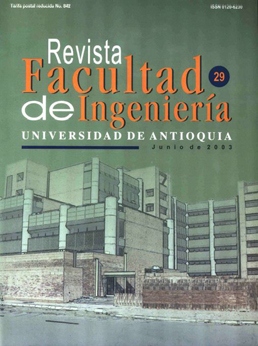Hidrodecloración catalítica de diclorometano sobre Pd o Ni soportados en r-alúmina sol-gel
DOI:
https://doi.org/10.17533/udea.redin.326571Keywords:
Hidrodecloración, diclorometano, alúmina, sol-gel, palado, níquel.Abstract
Se sintetizaron varios catalizadores cargados con paladio o níquel, soportados en y-alúmina preparada por el método sol-gel y se caracterizaron por difracción de rayos X, análisis elemental, adsorción de nitrógeno, TPR y TGA. Los catalizadores resultantes se evaluaron en la hidrodecloración catalítica de diclorometano al estudiar el efecto de varios parámetros: método de síntesis, condiciones de pretratamiento, temperatura de reacción, relación hidrógeno/organoclorado y tiempo de saturación. Bajo las condiciones estudiadas, los catalizadores impregnados exhibieron mayor actividad que los cogelados y la calcinación en flujo de He favoreció la actividad en comparación con la calcinación en condiciones estáticas. La actividad de los catalizadores aumentó con la temperatura y con la relación H2/CH2Cl2. El tiempo en que el catalizador se dejó en contacto con la mezcla reactiva antes de iniciar la reacción (tiempo de saturación) influyó significativamente en su actividad. En general, se observó disminución de la actividad catalítica con el tiempo de saturación. Aunque el soporte y-alúmina sol-gel también fue activo para la reacción, indudablemente el Pd y Ni promueven la hidrodecloración.
Downloads
References
Knapp, C. “Procesos para la reducción de emisiones gaseosas de compuestos organoclorados". Programa Iberoamericano de Ciencia y Tecnología para el Desarrollo CYTED. Agosto, 1998. pp. 61-66.
Tavoularis, G. y M. A. Keane. "Gas phase catalytic dehydrochlorination and hydrodechlorination of aliphatic and aromatic systems". Journal of Molecular Catalysis A: Chemical. No. 142. 1999. pp. 187-199. DOI: https://doi.org/10.1016/S1381-1169(98)00272-6
Early, K. O. et al. "Hydrogen-assisted 1,2,3- trichloropropane dechlorination on supported Pt-Sn catalysts". Applied Catalysis B: Environmental. No. 26. 2000. pp. 257-263. DOI: https://doi.org/10.1016/S0926-3373(00)00128-4
Malinowski, A. et al. "Hydrodechlorination of CH2Cl2 over Pd/y-Al203 Correlation with the hydrodechlorination of CCl2F2 (CFC-12)". Applied Catalysis B: Environmental. No. 19. 1998. L79-L86.
Ordoñez, S. et al. "Hydrodechlorination of aliphatic organochlorinated compounds over commercial hydrogenation catalysts". Applied Catalysis B: Environmental. No. 25. 2000. pp. 49-58. DOI: https://doi.org/10.1016/S0926-3373(99)00119-8
Prati, L. y M. Rossi. "Reductive catalytic dehalogenation of light chlorocarbons". Applied Catalysis B: Environmental. No. 23. 1999. pp. 135-142. DOI: https://doi.org/10.1016/S0926-3373(99)00071-5
Ordóñez, S. et al. "Catalytic hydrodechlorination of chlorinated olefins over a Pd/Al2O3 catalyst: Kinetics amd inhibition phenomena". lnd. Eng. Chem. Res. No. 41. 2002. pp. 505-511. DOI: https://doi.org/10.1021/ie010679v
Shin, E. J. y M. A. Keane. "Gas phase catalytic hydrodechlorination of chlorophenols using a supported nickel catalyst". Applied Catalysis B: Environmental. No. 18. 1998. pp. 241-250. DOI: https://doi.org/10.1016/S0926-3373(98)00043-5
Cesteros, Y. et al. "Catalytic hydrodechlorination on several alumina-supported nickel catalysts". Chemical lndustry and Environment II. pp. 667-672.
Cesteros, Y. et al. "Hydrodechlorination of 1,2,4 trichlorobenzene on nickel-based catalysts prepared from several Ni/Mg/Al hydrotalcite-like precursors". Applied Catalysis B: Environmental. No. 32. 2001. Pp. 25-35. DOI: https://doi.org/10.1016/S0926-3373(01)00129-1
Ocal, M. et al. "Conversion of CCl2F2 (CFC-12) in the presence and absence of H2 on sol-gel derived Pd/Al2O3 catalysts". Applied Catalysis B: Environmental. No. 21. 1999. pp. 279-289. DOI: https://doi.org/10.1016/S0926-3373(99)00027-2
Heinrichs, B. et al. "Palladium-silver sol-gel catalysts for selective hydrodechlorination of 1,2-dichloroethane into ethylene. III Kinetics and reaction mechanism". Journal of Catalysis. No. 192. 200 l. pp. 309-320. DOI: https://doi.org/10.1006/jcat.2001.3188
Kim, D. H. et al. "Effect ofpH in a sol-gel synthesis on the physicochemical properties of Pd-alumina threeway catalyst". Applied Catalysis B: Environmental. No. 26. 2000. pp. 285-289. DOI: https://doi.org/10.1016/S0926-3373(00)00132-6
Mizukauni, F. US Patent: 5780102, 1998.
Gonz.ález, R. D. et al. "Sol-gel preparation of supported metal catalysts". Catalysis Today. No. 35. 1997. pp. 293-317. DOI: https://doi.org/10.1016/S0920-5861(96)00162-9
Lemaitre, J. L. et al. "The measurement of catalyst dispersion". En: Characterization of heterogeneous catalysts. Delanny F. Ed., Marcel Dekker. New York, 1985. pp. 299-365.
Hurst, N. W. et al. "Temperature programmed reduction". Catalysis Reviews Science & Engineering. No. 24 (2). 1982. pp. 233-309. DOI: https://doi.org/10.1080/03602458208079654
Ordóñez, S. et al. "Characterisation of the deactivation ofplatinum and palladium supported on activated used as hydrodechlorination catalysts". Applied Catalysis B: Environmental. No. 31. 2001. pp. 113-122. DOI: https://doi.org/10.1016/S0926-3373(00)00270-8
Ordóñez, S. et al. "Thennogravimetric deterrnination of coke deposits on alumina-supported noble metal catalysts used as hydrodechlorination catalysts". Thermochimica Acta. No. 379. 2001. pp. 25-34. DOI: https://doi.org/10.1016/S0040-6031(01)00598-6
Bae, J. W. et al. "Hydrodechlorination of CCl4 over Pt/y-Al2O3 effects of reaction pressure and diluent gases on distribution of products and catalyst stability". Applied Catalysis A: General. No. 217. 2001. pp. 79-89. DOI: https://doi.org/10.1016/S0926-860X(01)00614-7
Weiss, A. H. et al. "Hydrodechlorination of carbon tetrachloride". Journal of Catalysis. No. 22. 1971. pp. 245-254. DOI: https://doi.org/10.1016/0021-9517(71)90191-6
Downloads
Published
How to Cite
Issue
Section
License
Revista Facultad de Ingeniería, Universidad de Antioquia is licensed under the Creative Commons Attribution BY-NC-SA 4.0 license. https://creativecommons.org/licenses/by-nc-sa/4.0/deed.en
You are free to:
Share — copy and redistribute the material in any medium or format
Adapt — remix, transform, and build upon the material
Under the following terms:
Attribution — You must give appropriate credit, provide a link to the license, and indicate if changes were made. You may do so in any reasonable manner, but not in any way that suggests the licensor endorses you or your use.
NonCommercial — You may not use the material for commercial purposes.
ShareAlike — If you remix, transform, or build upon the material, you must distribute your contributions under the same license as the original.
The material published in the journal can be distributed, copied and exhibited by third parties if the respective credits are given to the journal. No commercial benefit can be obtained and derivative works must be under the same license terms as the original work.










 Twitter
Twitter